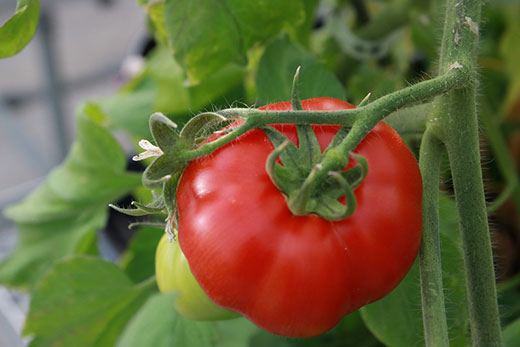 Tomatoes seem to prefer red colored plastic mulches. K-State horticulture expert Ward Upham says plastic mulches can help increase the production of marketable produce.
Tomatoes seem to prefer red colored plastic mulches. K-State horticulture expert Ward Upham says plastic mulches can help increase the production of marketable produce.
What color mulch do tomatoes prefer? Red, of course
Colored mulches can help increase production of some garden crops
April 22, 2021
MANHATTAN, Kan. – You may not think of tomatoes as a fickle fruit, but Kansas State University horticulture expert Ward Upham says that the popular garden crop can, indeed, be picky.
Upham noted that colored plastic mulches have gained favor over the more traditional black plastic mulch because they seem to increase the production of marketable fruit. Plastic mulches have long been known to promote earlier fruiting, increased yields and weed control.
“With tomatoes, the color of choice has been red (mulch),” Upham said.
When the season’s weather is ‘perfect’ for growing tomatoes, Upham said there may be no difference in production when using various plastic mulches. But when growing conditions are less than favorable, gardeners may experience up to a 20% increase in their tomato crop when using red mulch – though, on average, the increase is more like 12%.
For best results, Upham suggests home gardeners lay a drip irrigation line near the center of where the mulch will lay, because “the plastic will prevent rainwater or overhead irrigation from reaching the plants.”
Additional steps include:
- Use a hoe to construct trenches for the outer six inches of the plastic mulch. “This allows the center of the bed to be undisturbed, with the edges of the mulch draping down into the trench,” Upham said.
- Fill the trenches to cover the edges of the mulch. “This will prevent wind from catching and blowing the mulch,” according to Upham.
Fertilizing cole crops
In this week’s Horticulture Newsletter from K-State Research and Extension, Upham also shared tips for fertilizing such cole crops as cabbage, broccoli and cauliflower.
If those crops made it through recent cold snaps, they will need a fertilizer boost, he said. “These plants need to mature before summer heat arrives, so they must grow quickly while the weather is cool,” Upham said. “A side dressing of fertilizer about three weeks after transplanting helps these plants grow rapidly.”
Upham suggests using fertilizers high in nitrogen, such as nitrate of soda or blood meal at the rate of one-third cup per 10 feet of row. Fertilizer must be watered in, unless timely rains do the job for you.
More information on fertilizing cole crops is available in a fact sheet available from K-State Research and Extension.
Sharpening your mower’s blade
Upham also has advice for kicking off lawn-mowing season.
“Remember that a dull lawn mower blade gives the lawn a whitish cast,” he said. “A dull blade does not cut cleanly but rather shreds the ends of the leaf blades. The shredded ends dry out, giving the lawn that whitish look.”
He added that a sharp blade is even more important when turf starts putting up seeds next month. “The seed head stems are much tougher than the grass blades and more likely to shred,” he said.
Under normal use, mower blades should be sharpened every 10 hours of use.
Upham and his colleagues in K-State’s Department of Horticulture and Natural Resources produce a weekly Horticulture Newsletter with tips for maintaining home landscapes. The newsletter is available to view online or can be delivered by email each week.
Interested persons can also send their garden- and yard-related questions to Upham at wupham@ksu.edu, or contact your local K-State Research and Extension office.

